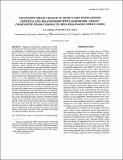Por favor, use este identificador para citar o enlazar a este item:
http://hdl.handle.net/10261/46218COMPARTIR / EXPORTAR:
 SHARE
BASE SHARE
BASE
|
|
| Visualizar otros formatos: MARC | Dublin Core | RDF | ORE | MODS | METS | DIDL | DATACITE | |

| Campo DC | Valor | Lengua/Idioma |
|---|---|---|
| dc.contributor.author | Abedon, B. G. | es_ES |
| dc.contributor.author | Revilla Temiño, Pedro | es_ES |
| dc.contributor.author | Tracy, W. F. | es_ES |
| dc.date.accessioned | 2012-02-24T12:55:13Z | - |
| dc.date.available | 2012-02-24T12:55:13Z | - |
| dc.date.issued | 1996 | - |
| dc.identifier.citation | Maydica 41: 77-82 (1996). | es_ES |
| dc.identifier.issn | 0025-6153 | - |
| dc.identifier.uri | http://hdl.handle.net/10261/46218 | - |
| dc.description.abstract | Vegetative development in maize can be divided into juvenile and adult phases, each, with distinct anatomy and physiology. Transition from juvenile to adult vegetative growth may have some adaptive value since adult leaves have increased photosynthetic rates, xeromorphism, and resistance to certain insects and diseases. Variation in the timing of this transition (i.e., the node(s) at which phase change occurs) may be associated with agronomic performance. Our objectives were to investigate the genetics of the timing of vegetative phase change and the relationship between phase-specific developmental and agronomically important traits in a diallel among open-pollinated sweet corn cultivars. Significant variability existed for most developmental traits evaluated in this study. Environmental effects were significant for some traits, whereas genotype x environment interaction (G x E) was significant only for number of leaves above the ear. General combining ability was significant and specific combining ability was not significant for most phase-specific developmental traits. Last leaf with juvenile wax and first leaf with adult wax were positively correlated. Ear leaf and total leaf number were not correlated with other phase-specific developmental traits. Flowering time was negatively correlated with first leaf with adult wax but was not correlated with last leaf with juvenile wax or last node with adventitious roots, indicating that some aspects of vegetative phase change are not associated with the transition to reproductive growth. Yield was not associated with any developmental trait in this study. First leaf with adult wax and last leaf with juvenile wax may be useful in selection indices, since they were not influenced by the environment, had no G x E interaction in this study, and have been associated with insect and disease resistance in previous studies. | es_ES |
| dc.language.iso | eng | es_ES |
| dc.publisher | Consiglio per la ricerca e la sperimentazione in agricoltura (Italia) | es_ES |
| dc.rights | openAccess | es_ES |
| dc.subject | Zea mays L. | es_ES |
| dc.subject | Development | es_ES |
| dc.subject | Combining ability | es_ES |
| dc.title | Vegetative phase change in sweet corn populations: Genetics and relationship with agronomic traits (vegetative phase change in open-pollinated sweet corn) | es_ES |
| dc.type | artículo | es_ES |
| dc.description.peerreviewed | Peer reviewed | es_ES |
| dc.relation.csic | Sí | es_ES |
| dc.type.coar | http://purl.org/coar/resource_type/c_6501 | es_ES |
| item.openairetype | artículo | - |
| item.grantfulltext | open | - |
| item.cerifentitytype | Publications | - |
| item.openairecristype | http://purl.org/coar/resource_type/c_18cf | - |
| item.fulltext | With Fulltext | - |
| item.languageiso639-1 | en | - |
| Aparece en las colecciones: | (MBG) Artículos | |
Ficheros en este ítem:
| Fichero | Descripción | Tamaño | Formato | |
|---|---|---|---|---|
| Revilla-Vegetative-phase.pdf | 1,8 MB | Adobe PDF |  Visualizar/Abrir |
CORE Recommender
Page view(s)
427
checked on 24-abr-2024
Download(s)
199
checked on 24-abr-2024
Google ScholarTM
Check
NOTA: Los ítems de Digital.CSIC están protegidos por copyright, con todos los derechos reservados, a menos que se indique lo contrario.
